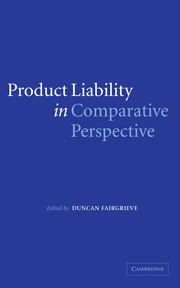Book contents
- Frontmatter
- Contents
- List of figures
- Foreword by Sir Michael Burton
- List of contributors
- Preface
- 1 Introduction
- PART I Country reports
- PART II European influences
- 9 Product liability: basic problems in a comparative law perspective
- 10 The development risks defence
- 11 Approaches to product liability in the EU and Member States
- 12 Product liability – a history of harmonisation
- PART III Comparing systems
- Appendix
- Index
11 - Approaches to product liability in the EU and Member States
from PART II - European influences
Published online by Cambridge University Press: 28 July 2009
- Frontmatter
- Contents
- List of figures
- Foreword by Sir Michael Burton
- List of contributors
- Preface
- 1 Introduction
- PART I Country reports
- PART II European influences
- 9 Product liability: basic problems in a comparative law perspective
- 10 The development risks defence
- 11 Approaches to product liability in the EU and Member States
- 12 Product liability – a history of harmonisation
- PART III Comparing systems
- Appendix
- Index
Summary
The essential components of product liability
In considering the state and nature of product liability, one needs to remind oneself that several different areas need to be examined:
substantive law on liability
mechanisms for funding lawyers and court costs, and the extent and proportionality of the financial risk to claimant and defendant
rules of procedure
law on damages
sometimes, conflict/jurisdictional issues such as proper law, jurisdiction and enforcement of judgments.
This is fertile ground for comparative lawyers, which is made more interesting since all of these areas are potentially subject to reform. But one's ardour is somewhat dampened by the consistent evidence that product liability is not a major phenomenon in any EU state. This is also my personal experience over the past ten or so years in handling claims for a number of manufacturers, covering a range of consumer and industrial product sectors, and their insurers, that may arise in any European jurisdiction. One of the jurisdictions that has consistently been most active for individual claims is Russia, where there are unregulated contingency fees, few controls on the accuracy of media statements, and questionable standards in the judicial system.
Substantive law
The rules on strict liability for defective products are relatively stable (Directive 85/374) and firmly implemented into national provisions of member states and applicant states. There has been a small number of instances of incorrect implementation but the Commission and ECJ are well advanced in sorting these out.
- Type
- Chapter
- Information
- Product Liability in Comparative Perspective , pp. 192 - 201Publisher: Cambridge University PressPrint publication year: 2005
- 1
- Cited by



